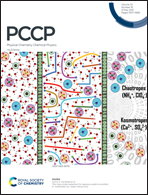CO2 activation and dissociation on In2O3(110) supported PdnPt(4−n) (n = 0–4) catalysts: a density functional theory study†
Abstract
Converting CO2 into valuable chemicals via catalytic reactions can mitigate both the greenhouse effect and energy shortage problems, thus designing efficient catalysts have attracted considerable attention over the past decades. In this work, a density functional theory (DFT) calculation was carried out to investigate the CO2 activation and dissociation processes on various PdnPt(4−n)/In2O3 (n = 0–4) catalysts. The PdnPt(4−n)/In2O3 models were initially built, and the interface sites of PdnPt(4−n)/In2O3 for CO2 adsorption were confirmed among cluster sites and substrate sites. The CO2 adsorption geometries, charger transfer, and projected density of states (PDOS) were analyzed to study the CO2–PdnPt(4−n)/In2O3 interactions. From the adsorbed *CO2, the transition states (TSs) for CO2 dissociation to form *CO and *O were gained to reveal the characteristics of the activated CO2δ−. Overall, according to the adsorption energy Eads results, the bimetallic PdPt3/In2O3 and Pd3Pt/In2O3 catalysts showed the strongest and weakest CO2 adsorption stabilities, respectively, while the Pd element addition decreases the barriers for CO2 dissociation with the priority order of Pd4 > Pd3Pt > Pd2Pt2 > PdPt3 > Pt4. The Brønsted–Evans–Polanyi (BEP) relation between activation barriers (Eb) and reaction energies E was obtained for the CO2 dissociation mechanism on PdnPt(4−n)/In2O3 catalysts with the equation of E = 0.20Eb + 0.40. Finally, the optimal Pd2Pt2/In2O3 catalyst for CO2 activation and dissociation was proposed. This study provides useful information for CO2 activation and conversation procedures on bimetal-oxide catalysts, and helps to take the optimal design of PdPt/In2O3 catalysts for the CO2 reaction.



 Please wait while we load your content...
Please wait while we load your content...